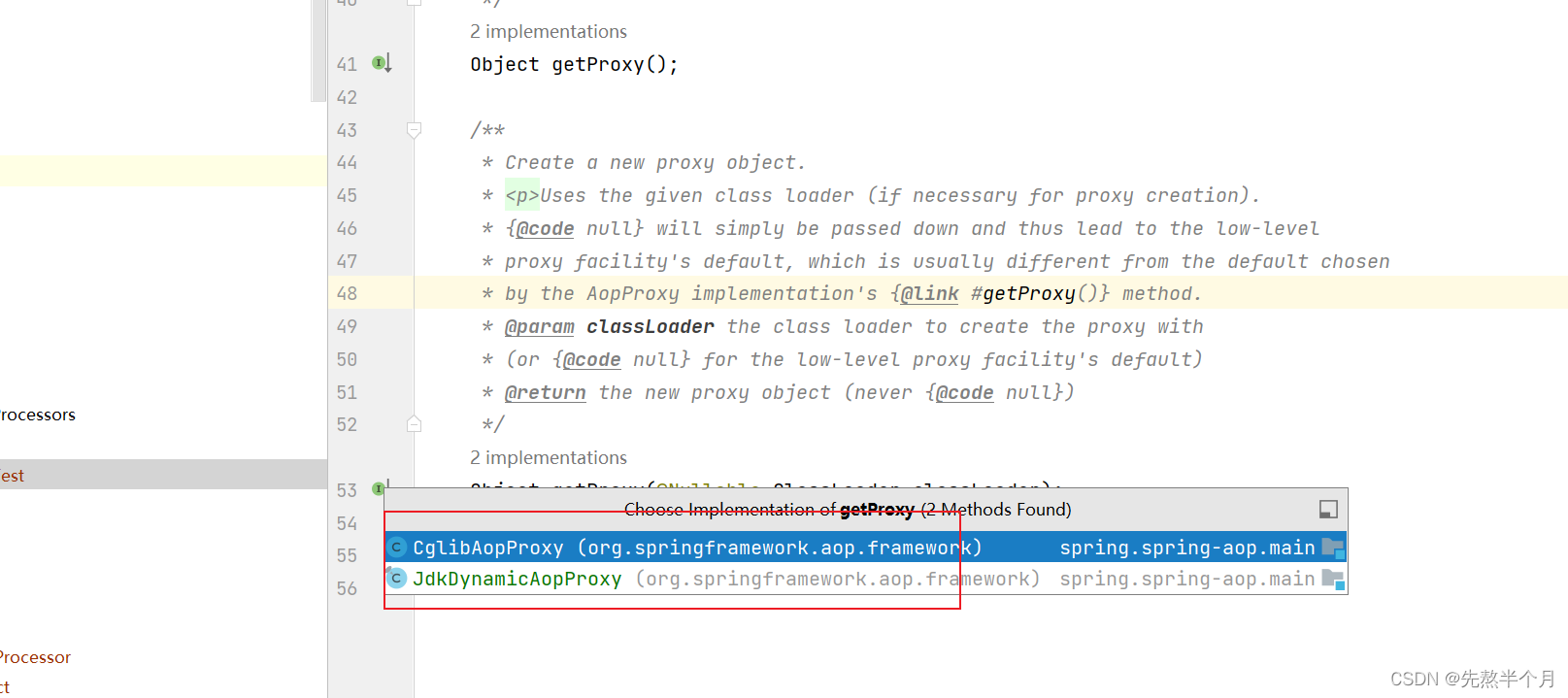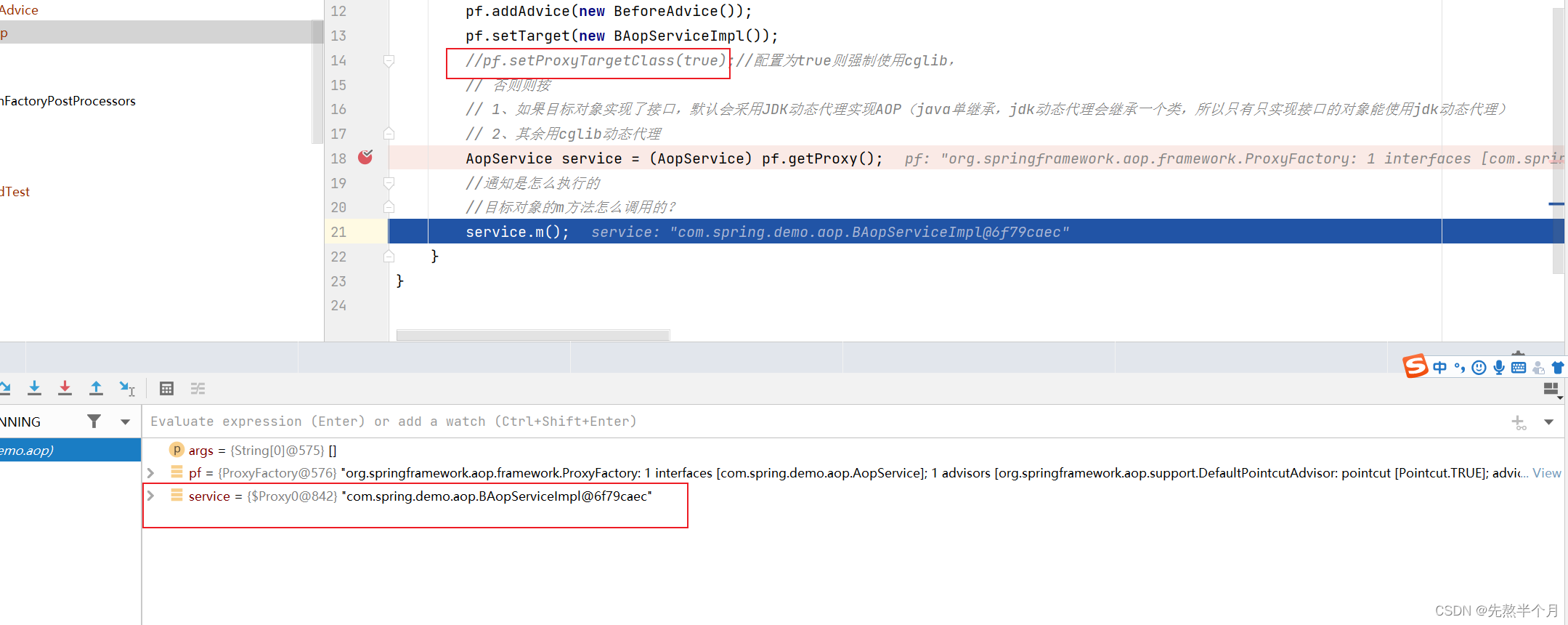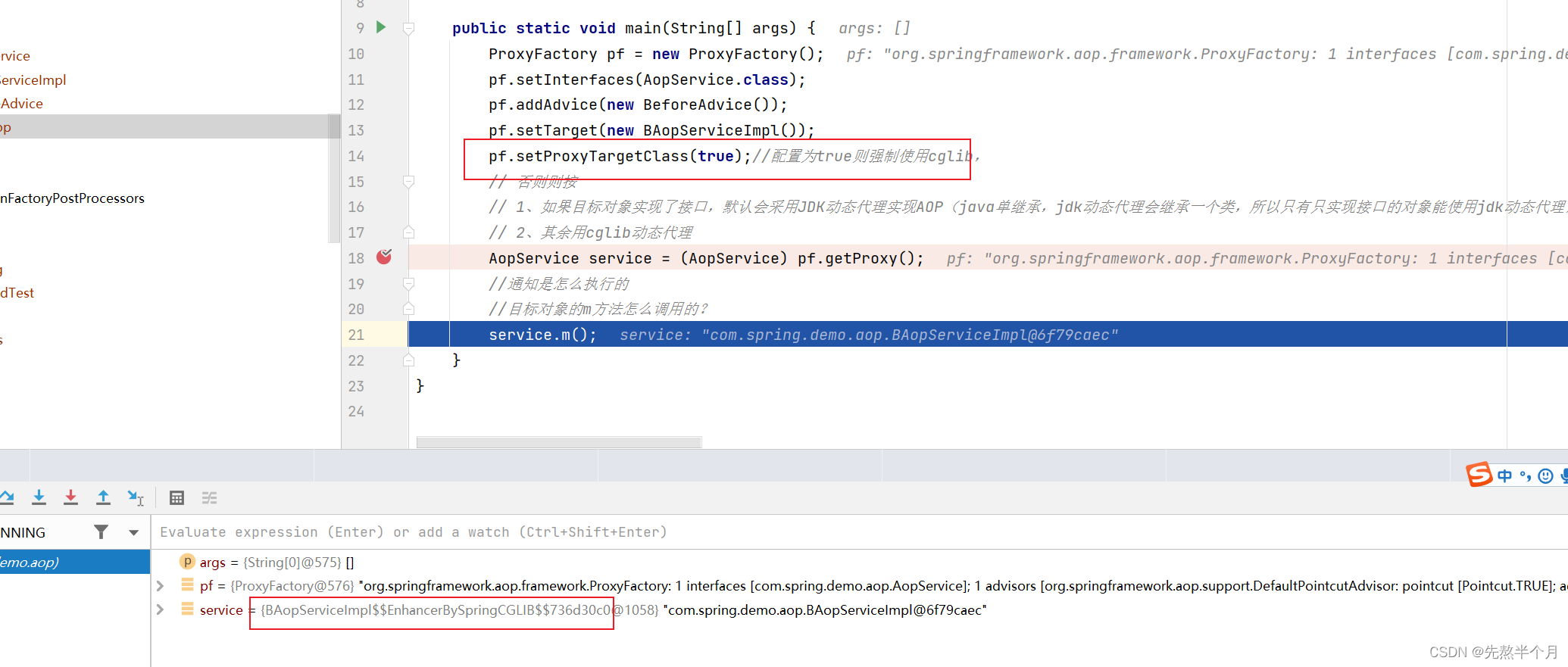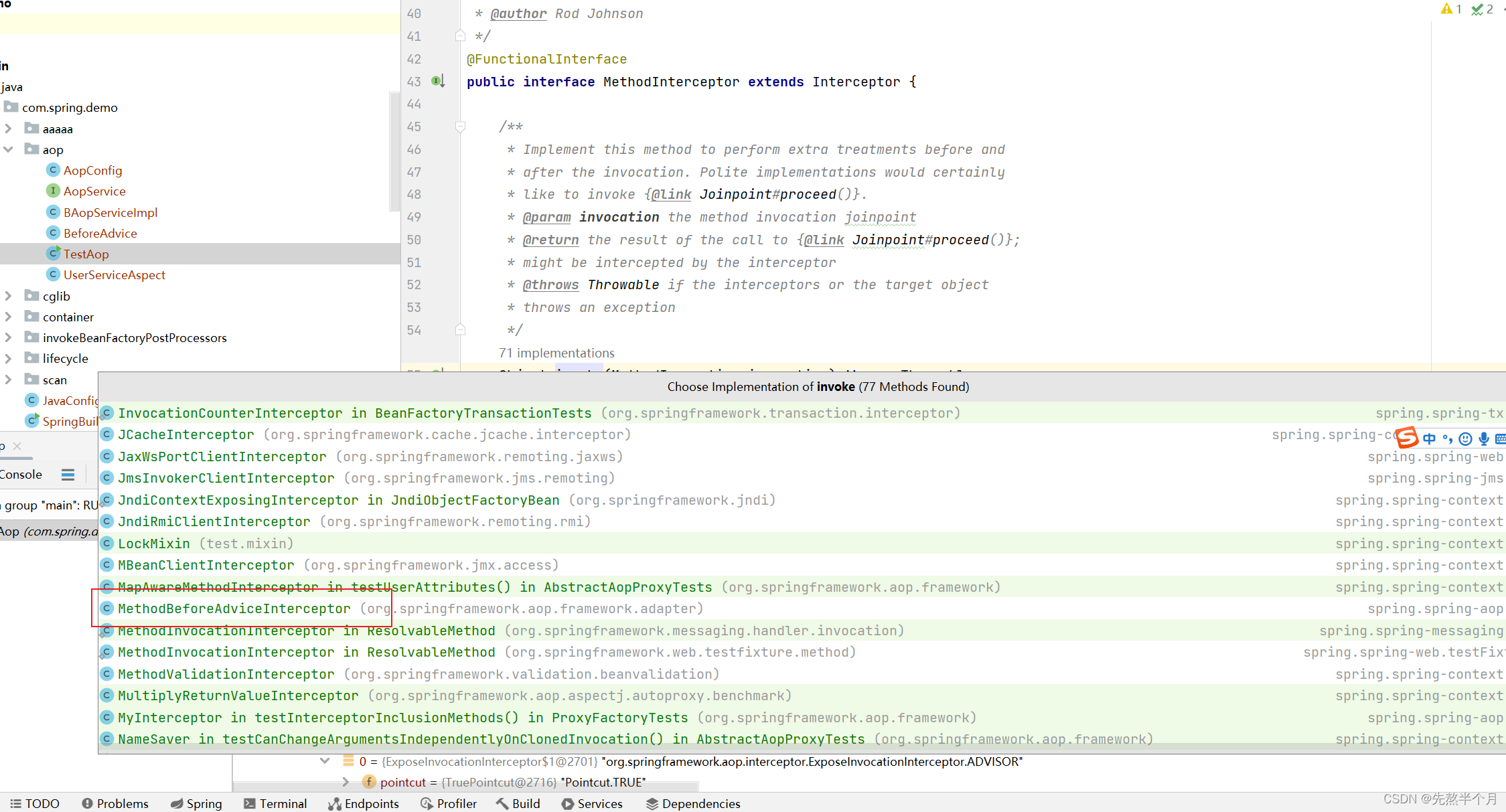spring aop的应用这里就不讲了,自己百度
我们先看aop是什么时候被调用的,即使用了aop的bean的BeanPostProcessor的实现方法postProcessBeforeInitialization什么时候被调用的(我们都知道bean的什么周期有个扩展点就是BeanPostProcessor)
refresh方法--》finishBeanFactoryInitialization(beanFactory)
--》beanFactory.preInstantiateSingletons();--》getBean(beanName)
----》doGetBean---》createBean---》doCreateBean
protected Object doCreateBean(String beanName, RootBeanDefinition mbd, @Nullable Object[] args)
throws BeanCreationException {
// Instantiate the bean.
BeanWrapper instanceWrapper = null;
if (mbd.isSingleton()) {
instanceWrapper = this.factoryBeanInstanceCache.remove(beanName);
}
if (instanceWrapper == null) {
//实例化对象(这里获取到的是原生对象)
instanceWrapper = createBeanInstance(beanName, mbd, args);
}
Object bean = instanceWrapper.getWrappedInstance();
Class<?> beanType = instanceWrapper.getWrappedClass();
//省略部分代码。。。。。
// Initialize the bean instance.
Object exposedObject = bean;
try {
populateBean(beanName, mbd, instanceWrapper);
//完成调用BeanPostProcessor的实现方法postProcessBeforeInitialization
exposedObject = initializeBean(beanName, exposedObject, mbd);
}
//省略部分代码。。。。。
}我们继续进入initializeBean--》applyBeanPostProcessorsAfterInitialization
@Override
public Object applyBeanPostProcessorsAfterInitialization(Object existingBean, String beanName)
throws BeansException {
Object result = existingBean;
//遍历所以的BeanPostProcessor
for (BeanPostProcessor processor : getBeanPostProcessors()) {
//如果使用了AOP,则会在这里调用其实现方法(即代理的增强逻辑)
Object current = processor.postProcessAfterInitialization(result, beanName);
if (current == null) {
return result;
}
result = current;
}
//此时返回代理对象
return result;
}此时我们知道spring中bean的aop是什么时候被代理的,而还不知道springaop是怎么在BeanPostProcessor扩展点进行代理的?
我们进入
postProcessAfterInitialization方法----》找到其实现类AbstractAutoProxyCreator:
---》wrapIfNecessary:
//部分代码
// Create proxy if we have advice.
Object[] specificInterceptors = getAdvicesAndAdvisorsForBean(bean.getClass(), beanName, null);
if (specificInterceptors != DO_NOT_PROXY) {
this.advisedBeans.put(cacheKey, Boolean.TRUE);
//获取代理对象
Object proxy = createProxy(
bean.getClass(), beanName, specificInterceptors, new SingletonTargetSource(bean));
this.proxyTypes.put(cacheKey, proxy.getClass());
return proxy;
}我们继续进去这个createProxy方法:
protected Object createProxy(Class<?> beanClass, @Nullable String beanName,
@Nullable Object[] specificInterceptors, TargetSource targetSource) {
if (this.beanFactory instanceof ConfigurableListableBeanFactory) {
AutoProxyUtils.exposeTargetClass((ConfigurableListableBeanFactory) this.beanFactory, beanName, beanClass);
}
//创建一个代理工厂
ProxyFactory proxyFactory = new ProxyFactory();
proxyFactory.copyFrom(this);
if (proxyFactory.isProxyTargetClass()) {
// Explicit handling of JDK proxy targets (for introduction advice scenarios)
if (Proxy.isProxyClass(beanClass)) {
// Must allow for introductions; can't just set interfaces to the proxy's interfaces only.
for (Class<?> ifc : beanClass.getInterfaces()) {
proxyFactory.addInterface(ifc);
}
}
}
else {
// No proxyTargetClass flag enforced, let's apply our default checks...
if (shouldProxyTargetClass(beanClass, beanName)) {
proxyFactory.setProxyTargetClass(true);
}
else {
evaluateProxyInterfaces(beanClass, proxyFactory);
}
}
Advisor[] advisors = buildAdvisors(beanName, specificInterceptors);
proxyFactory.addAdvisors(advisors);
//设置目标对象(即原生对象)
proxyFactory.setTargetSource(targetSource);
customizeProxyFactory(proxyFactory);
proxyFactory.setFrozen(this.freezeProxy);
if (advisorsPreFiltered()) {
proxyFactory.setPreFiltered(true);
}
//通过工厂获取代理对象(这里的工厂会通过上面的一些配置,选择要使用jdk动态代理还是cglib动态代理)
return proxyFactory.getProxy(getProxyClassLoader());
}
/**我们进去getProxy方法---》createAopProxy().getProxy(classLoader)

可以看到,这就有两个实现类,一个是cglib动态代理、一个是jdk动态代理。

此时我们再回到源码,我们不看getProxy,而是看createAopProxy怎么返回对应的实现类的。
public Object getProxy(@Nullable ClassLoader classLoader) {
return createAopProxy().getProxy(classLoader);
}
createAopProxy---》getAopProxyFactory().createAopProxy(this);
最后进入
DefaultAopProxyFactory类的createAopProxy方法:
@Override
public AopProxy createAopProxy(AdvisedSupport config) throws AopConfigException {
// isOptimize: 是否对代理进行优化
// isProxyTargetClass: 值为true,使用CGLIB代理,默认false
/**
* hasNoUserSuppliedProxyInterfaces:
* 1:接口是不是满足,如果长度为0;也就是接口为空,返回false
* 2:如果接口类型不是SpringProxy类型的,也返回flase
*/
//所以配置了@EnableAspectJAutoProxy(proxyTargetClass = true) || (没有实现接口 ||接口类型不是SpringProxy类型)走这个分支
if (config.isOptimize() || config.isProxyTargetClass() || hasNoUserSuppliedProxyInterfaces(config)) {
Class<?> targetClass = config.getTargetClass();
if (targetClass == null) {
throw new AopConfigException("TargetSource cannot determine target class: " +
"Either an interface or a target is required for proxy creation.");
}
//目标对象是否是接口等,一般不成立
if (targetClass.isInterface() || Proxy.isProxyClass(targetClass)) {
return new JdkDynamicAopProxy(config);
}
//使用cglib代理
return new ObjenesisCglibAopProxy(config);
}
else {
//其他情况(即没有配置强制使用cglib或实现了接口的)直接使用jdk
return new JdkDynamicAopProxy(config);
}
}
这里得出如何选用cglib和jdk动态代理:
1、如果目标对象实现了接口,则使用jdk动态代理。但可配置强制使用cglib
2、其他情况使用cglib
1、JDK动态代理只提供接口的代理,不支持类的代理,jdk会在运行时为目标类生成一个 $proxy*.class,该代理类是实现了目标类接口的一个类,并且会实现接口所有的方法增强代码,调用时, 通过先去调用处理类进行增强,再通过反射的方式进行调用目标方法,从而实现AOP
2、如果代理类 没有实现接口,那么spring AOP会选择使用CGLIB来动态代理目标类,CGLIB的底层是通过ASM在运行时动态的生成目标类的一个子类,(还有其他相关的多个类,主要是为了增强调用时的效率),并且会重写父类所有的方法增强代码,调用时会先通过代理类进行增强,再直接调用父类对应的方法进行调用目标方法,从而实现AOP
注意:springboot2.x中对aop源码进行修改,默认使用的是cglib,且强制配置参数无效,具体看:
【惊人】Spring5 AOP 默认使用Cglib? 从现象到源码深度分析_spring5.0+cglib_HD243608836的博客-CSDN博客
我们不急着看其他的,我们可以来手动模拟这个过程
接口:
public interface AopService {
public void m();
default public String m1(Integer i) {
return "m1";
}
}实现类:
@Component("b")
public class BAopServiceImpl implements AopService {
@Override
public void m() {
System.out.println("b -BAopServiceImpl");
}
}
模拟的通知:
public class BeforeAdvice implements MethodInterceptor {
//为什么需要穿这个对象MethodInvocation
//为了执行链上的下一个增强器
@Override
public Object invoke(MethodInvocation invocation) throws Throwable {
System.out.println(" aop------before advice");
return invocation.proceed(); //放行
}
}
测试类:
public class TestAop {
public static void main(String[] args) {
ProxyFactory pf = new ProxyFactory();
//给工厂设置一个接口,这样工厂会知道要基于接口代理,这样工厂就会使用jdk动态代理
pf.setInterfaces(AopService.class);
pf.addAdvice(new BeforeAdvice());
pf.setTarget(new BAopServiceImpl());
//pf.setProxyTargetClass(true);//配置为true则强制使用cglib,
AopService service = (AopService) pf.getProxy();
//通知是怎么执行的
//目标对象的m方法怎么调用的?
service.m();
}
}
我们debug看看获取的对象是使用什么代理:

此时使用的是jdk,然后我们把这个注释放开再次debug:

此时则使用cglib动态代理(即使你使用pf.setInterfaces(AopService.class)告诉代理工厂实现了接口,但是pf.setProxyTargetClass(true)的优先级是大于前者的)
我们再次修改实现类,让他去随便继承一个类,然后把强制使用cglib+配置接口注释掉
public class TestAop {
public static void main(String[] args) {
ProxyFactory pf = new ProxyFactory();
//给工厂设置一个接口,这样工厂就会使用jdk动态代理
//pf.setInterfaces(AopService.class);
pf.addAdvice(new BeforeAdvice());
pf.setTarget(new BAopServiceImpl());
//pf.setProxyTargetClass(true);//配置为true则强制使用cglib,
AopService service = (AopService) pf.getProxy();
//通知是怎么执行的
//目标对象的m方法怎么调用的?
service.m();
}
}
@Component("b")
public class BAopServiceImpl extends JavaConfig implements AopService {
@Override
public void m() {
System.out.println("b -BAopServiceImpl");
}
}运行后会发现不管有没有继承了其他类都会只使用cgtlib动态代理,因为我们并没有让代理工厂感知到目标对象要基于接口进行代理,所以会一直使用cglib。
那么到此我们知道,如果要使用jdk动态代理要让代理工厂知道要基于接口代理。
我们继续往里面看,先看jdk动态代理类JdkDynamicAopProxy的部分代码:
//代理工厂
private final AdvisedSupport advised;
public JdkDynamicAopProxy(AdvisedSupport config) throws AopConfigException {
Assert.notNull(config, "AdvisedSupport must not be null");
if (config.getAdvisors().length == 0 && config.getTargetSource() == AdvisedSupport.EMPTY_TARGET_SOURCE) {
throw new AopConfigException("No advisors and no TargetSource specified");
}
this.advised = config;
}进去到getProxy方法():
@Override
public Object getProxy(@Nullable ClassLoader classLoader) {
if (logger.isTraceEnabled()) {
logger.trace("Creating JDK dynamic proxy: " + this.advised.getTargetSource());
}
//获取到代理接口
Class<?>[] proxiedInterfaces = AopProxyUtils.completeProxiedInterfaces(this.advised, true);
findDefinedEqualsAndHashCodeMethods(proxiedInterfaces);
//获取代理对象
return Proxy.newProxyInstance(classLoader, proxiedInterfaces, this);
}这里获取的接口就是目标对象实现的接口(也就是我们前面说的让工厂对象感知到的接口)
----------------------------------
到这里我们已经知道spring是怎么去选择代理方式的,现在我们看看aop是怎么进行通知?
我们以jdk动态代理为例子进行说明:
我们以JdkDynamicAopProxy类的invoke方法为入口:
@Override
@Nullable
public Object invoke(Object proxy, Method method, Object[] args) throws Throwable {
Object oldProxy = null;
boolean setProxyContext = false;
//获取到目标对象的包裹对象
TargetSource targetSource = this.advised.targetSource;
Object target = null;
//省略部分代码。。。。。
Object retVal;
if (this.advised.exposeProxy) {
// Make invocation available if necessary.
oldProxy = AopContext.setCurrentProxy(proxy);
setProxyContext = true;
}
// Get as late as possible to minimize the time we "own" the target,
// in case it comes from a pool.
//获取目标对象
target = targetSource.getTarget();
Class<?> targetClass = (target != null ? target.getClass() : null);
//省略部分代码。。。。。
// Get the interception chain for this method.
//获取代理工厂中的增强器(即通知)
List<Object> chain = this.advised.getInterceptorsAndDynamicInterceptionAdvice(method, targetClass);
// Check whether we have any advice. If we don't, we can fallback on direct
// reflective invocation of the target, and avoid creating a MethodInvocation.
if (chain.isEmpty()) {
// We can skip creating a MethodInvocation: just invoke the target directly
// Note that the final invoker must be an InvokerInterceptor so we know it does
// nothing but a reflective operation on the target, and no hot swapping or fancy proxying.
Object[] argsToUse = AopProxyUtils.adaptArgumentsIfNecessary(method, args);
retVal = AopUtils.invokeJoinpointUsingReflection(target, method, argsToUse);
}
else {
//new一个MethodInvocation对象,存在代理工厂、目标对象、目标方法、参数、通知等
// We need to create a method invocation...
MethodInvocation invocation =
new ReflectiveMethodInvocation(proxy, target, method, args, targetClass, chain);
// Proceed to the joinpoint through the interceptor chain.
//执行
retVal = invocation.proceed();
}
//省略部分代码。。。。。
}
我们继续进入proceed()方法:

进入该类的实现方法:
@Override
@Nullable
public Object proceed() throws Throwable {
// We start with an index of -1 and increment early.
//判断链上还有没有通知或者增强器(currentInterceptorIndex默认为-1,每执行一次则加1)
//interceptorsAndDynamicMethodMatchers.size()表示有多少个通知
if (this.currentInterceptorIndex == this.interceptorsAndDynamicMethodMatchers.size() - 1) {
//如果没有通知了,则执行目标对象的目标方法
return invokeJoinpoint();
}
//每调用一次proceed方法会+1(用来控制执行完执行链上的通知)
Object interceptorOrInterceptionAdvice =
this.interceptorsAndDynamicMethodMatchers.get(++this.currentInterceptorIndex);
if (interceptorOrInterceptionAdvice instanceof InterceptorAndDynamicMethodMatcher) {
// Evaluate dynamic method matcher here: static part will already have
// been evaluated and found to match.
InterceptorAndDynamicMethodMatcher dm =
(InterceptorAndDynamicMethodMatcher) interceptorOrInterceptionAdvice;
Class<?> targetClass = (this.targetClass != null ? this.targetClass : this.method.getDeclaringClass());
if (dm.methodMatcher.matches(this.method, targetClass, this.arguments)) {
return dm.interceptor.invoke(this);
}
else {
// Dynamic matching failed.
// Skip this interceptor and invoke the next in the chain.
return proceed();
}
}
else {
//执行通知(增强逻辑)
//然后在对应实现类中会递归调用proceed()方法执行下一个通知/目标对象方法
// It's an interceptor, so we just invoke it: The pointcut will have
// been evaluated statically before this object was constructed.
return ((MethodInterceptor) interceptorOrInterceptionAdvice).invoke(this);
}
}可以看到,如果执行链上还有通知会先走执行通知的分支,等到通知走完才会去执行目标对象的目标方法。
那么此时我们是否有个疑问,假设我们设置了两个通知,一个before、一个after,那么正确的执行顺序应该是before通知--》目标方法--》after通知,而我们这里看到的代码不是先执行完通知再执行目标方法吗?这是怎么回事?
我们可以先去看看进去invoke方法中:
((MethodInterceptor) interceptorOrInterceptionAdvice).invoke(this)

此时是个接口,我们先看before通知的实现:
@Override
public Object invoke(MethodInvocation mi) throws Throwable {
//1、先调用通知增强逻辑
this.advice.before(mi.getMethod(), mi.getArguments(), mi.getThis());
//2、递归调用下一个通知/目标方法
return mi.proceed();
}可以看到before先调用通知增强逻辑,然后重新递归调用proceed方法,此时到proceed方法后由于我们又有一个after通知,所以还会走执行通知的分支,那么我们此时进去after通知的实现方法看看:

@Override
public Object invoke(MethodInvocation mi) throws Throwable {
try {
//1、先递归回去调用proceed方法
return mi.proceed();
}
finally {
//2、再执行通知
invokeAdviceMethod(getJoinPointMatch(), null, null);
}
}这里就可以发现了,after和before是相反的,他是先递归调用proceed方法,然后由于没有其他通知了,就会调用目标方法,最后再去调用after的通知。
所以最终的执行顺序为before通知--》目标方法--》after通知。
-----------------------------------------------------------------------------
BeanPostProcessor:看下一篇文章
aaaaa





















 5823
5823











 被折叠的 条评论
为什么被折叠?
被折叠的 条评论
为什么被折叠?








